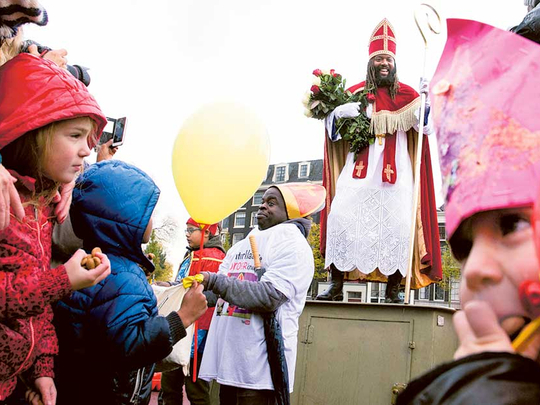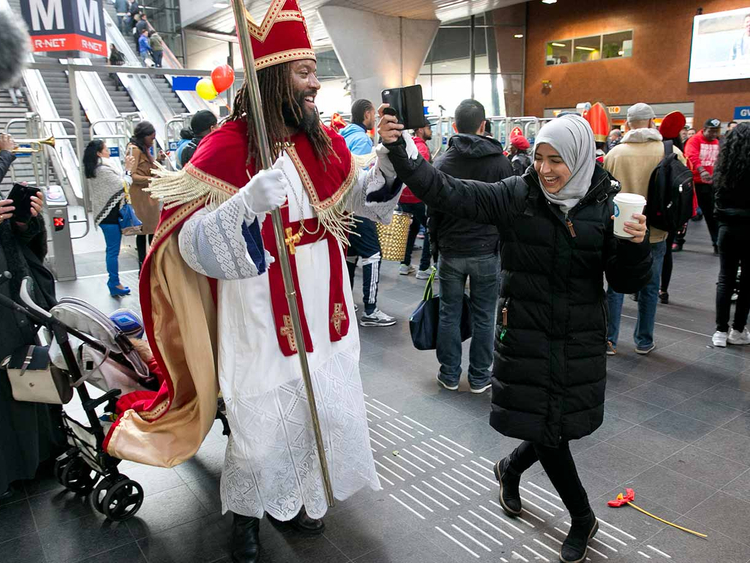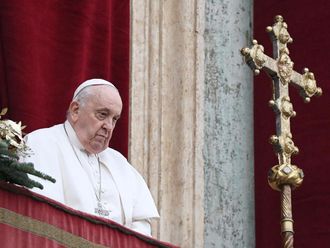
Amsterdam: The steamboat carrying the Dutch equivalent of Santa Claus is not due to chug into the historic harbour of Maassluis until next weekend, but the acrimonious annual debate about his helper ‘Black Pete’ has been under way for weeks.
The Christmas-like celebration of Sinterklaas, or Saint Nicholas, on December 5 has in recent years become the backdrop for a polarised discourse about race in this multiethnic nation of 17 million, drawing in the Netherlands’ historic role in the slave trade and the place in society of people of colour from former Dutch colonies and more recent migrants.
At the heart of the discussion is ‘Black Pete’, Sinterklaas’ helper who is often played by white people in blackface make-up and Afro wigs. Opponents see him as an outdated and offensive caricature that harks back to slavery, while the majority of Dutch people see Pete as a harmless children’s character who has come to symbolise what they see as attacks on Dutch culture and traditions.
On Saturday, a ‘New Sint’, played by a black actor with dreadlocks spilling out from under the gold trimmed red mitre worn by the traditional Sinterklaas, gave the old party a new twist.
Accompanied by break dancers, a brass band and drummers, he rode the subway from Amsterdam city hall to a mainly migrant neighbourhood handing out red and white roses and dancing with people he met, from a policewoman to a Muslim mother.
“I think it is great to come together like this and show that you can have a party even without that character with his negative elements referring back to slavery,” said Miguel Heilbron, who took his two young children to see the new Sinterklaas.
“You show that you can have a great party without that character,” he added as helpers wearing T-shirts emblazoned with the message ‘Sinterklas without helper’ handed out fruit and small cookies known as pepernoten to children.
In a sign that Pete could even become a player in parliamentary elections due next March, the leader of the ruling Liberal Party accused the commercial television network RTL of effectively killing off the Sinterklaas celebration by banishing blackface Black Petes from its airwaves and replacing him with Chimney Pete, his face darkened by soot.
Traditionalists, who are in the majority, say Pete should not change.
“For me, Black Pete has to stay black. It’s our culture,” said Anneke Krowinkel as the New Sint passed her in an Amsterdam shopping street. “It’s a children’s party and has nothing to do with discrimination.”
Deputy Prime Minister Lodewijk Asscher, of the centre-left Labor Party, last month met with critics and supporters in an attempt to calm the debate.
“We distance ourselves from every form of threat, violence, polarisation and aggression,” the groups said in a joint statement. “We appeal for calm and a civilised and respectful dialogue.”
Even the United Nations has weighed in, with its Committee on the Elimination of Racial Discrimination last year urging the Netherlands to “actively promote the elimination of those features of the character of Black Pete which reflect negative stereotypes and are experienced by many people of African descent as a vestige of slavery.”
The Dutch national “Children’s Ombudsman” also warned that Black Pete can “contribute to bullying, exclusion or discrimination” and is in breach of the United Nations Convention on the Rights of the Child.
Despite the criticism and calls for change, Prime Minister Mark Rutte has repeatedly declined to get involved, saying it is not up to the government to decide on Black Pete’s appearance.
Others are not so reticent.
Members of an organisation called Kick Out Black Pete and supporters of a far-right wing group the Dutch People’s Union have both announced plans to demonstrate on November 12, when Sinterklaas and his entourage arrive in Maassluis. Last year, the event took place in the city of Gouda, where police arrested several anti-Black Pete protesters.
The arrival will be shown live by the NTR public broadcaster, which also airs a nightly ‘Sinterklaasjournal’ news show about the fictional Sinterklaas’ activities in the days leading up to December 5.
Amsterdam, which hosts its own arrival of Sinterklaas next weekend, is following RTL’s lead and using Chimney Petes whose faces have been smudged with soot from clambering down chimneys to deliver gifts to children. The city has been at the forefront of the gradual evolution of Black Pete, increasingly replacing the blackface version with characters with different-coloured face paint.
At Saturday’s unofficial celebration in Amsterdam, there were no Petes at all.
“If you look at this party, you see only saints, so for me this is the St. Nicholas party,” the New Sint, Patrick Mathurin, said. “You see only happy people. People of all colour together with a positive message.”













